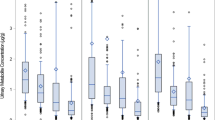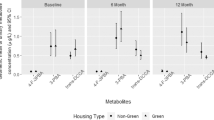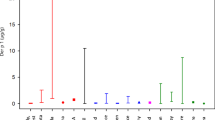Abstract
The impact of the US EPA-required phase-outs starting in 2000–2001 of residential uses of the organophosphate (OP) pesticides chlorpyrifos (CPF) and diazinon (DZN) on preschool children's pesticide exposures was investigated over 2003–2005, in the Raleigh-Durham-Chapel Hill area of North Carolina. Data were collected from 50 homes, each with a child initially of age 3 years (OCh) and a younger child (YCh). Environmental samples (indoor and outdoor air, dust, soil) and child-specific samples (hand surface residue, urine, diet) were collected annually over 24-h periods at each home. Child time-activity diaries and household pesticide use information were also collected. Analytes included CPF and DZN; pentachlorophenol (PCP); 2,4-dichlorophenoxyacetic acid (2,4-D); the CPF metabolite 3,5,6-trichloro-2-pyridinol (TCP); and the DZN metabolite 2-isopropyl-6-methyl-4-pyrimidinol (IMP). Exposures (ng/day) through the inhalation, dietary ingestion, and indirect ingestion were calculated. Aggregate potential doses in ng/kg body weight per day (ng/kg/day) were obtained by summing the potential doses through the three routes of exposure. Geometric mean aggregate potential doses decreased from 2003 to 2005 for both OCh and YCh, with the exception of 2,4-D. Child-specific longitudinal modeling indicated significant declines across time of the potential doses of CPF, DZN, and PCP for both children; declines of IMP for both children, significant only for OCh; a decline of TCP for OCh but an increase of TCP for YCh; and no significant change of 2,4-D for either child. Age-adjusted modeling indicated significant effects of the child's age for all except CPF, and of time for all except PCP and 2,4-D. Within-home variability was small compared with that between homes; variability was smallest for 2,4-D, both within and between homes. The aggregate potential doses of CPF and DZN were well below published reference dose values. These findings show the success of the US EPA restrictions in reducing young children's pesticide exposures.
This is a preview of subscription content, access via your institution
Access options
Subscribe to this journal
Receive 6 print issues and online access
$259.00 per year
only $43.17 per issue
Buy this article
- Purchase on Springer Link
- Instant access to full article PDF
Prices may be subject to local taxes which are calculated during checkout

Similar content being viewed by others
References
Adgate J.L., Barr D.B., Clayton C.A., Eberly L.E., Freeman N.C., Lioy P.J., Needham L.L., Pellizzari E.D., Quackenboss J.J., Roy A., and Sexton K. Measurement of children's exposure to pesticides: analysis of urinary metabolite levels in a probability-based sample. Environ Health Perspect 2001: 109: 583–590.
Alexander B.H., Mandel J.S., Baker B.A., Burns C.J., Bartels M.J., Acquavella J.F., and Gustin C. Biomonitoring of 2,4-dichlorophenoxyacetic acid exposure and dose in farm families. Environ Health Perspect 2007: 115: 370–376.
Arcury T.A., Grzywacz J.G., Barr D.B., Tapia J., Chen H., and Quandt S.A. Pesticide urinary metabolite levels of children in eastern North Carolina farmworker households. Environ Health Perspect 2007: 115: 1254–1260.
Arcury T.A., Grzywacz J.G., Davis S.W., Barr D.B., and Quandt S.A. Organophosphorus pesticide urinary metabolite levels of children in farmworker households in eastern North Carolina. Am J Ind Med 2006: 49: 751–760.
ASTM. Standard practice for collection of floor dust for chemical analysis D5438-94. Annual Book of ASTM Standards. American Society for Testing and Materials, West Conshohoken, PA,, 1997, Vol. 11.03, pp. 517–523.
ATSDR. Toxicological Profile for Chlorpyrifos. U.S. Department of Health and Human Services, Agency for Toxic Substances and Disease Registry, Atlanta, GA, 1997.
ATSDR. Draft Toxicological Profile for Diazinon. U.S. Department of Health and Human Services, Agency for Toxic Substances and Disease Registry, Atlanta, GA, 2006.
Ballauf A., Kersting M., and Manz F. Do children have an adequate fluid intake? Water balance studies carried out at home. Ann Nutr Metab 1988: 32: 332–339.
Bradman M.A., Harnly M.E., Draper W., Seidel S., Teran S., Wakeham D., and Neutra R. Pesticide exposures to children from California's central valley—Results of a pilot study. J Expo Anal Environ Epidemiol 1997: 7: 217–234.
Chuang J.C., Lyu C., Chou Y.-L., Callahan P.J., Nishioka M., Andrews K., Pollard M.A., Brackney L., Hines C., Davis D.B., and Menton R. Evaluation and application of methods for estimating children's exposure to persistent organic pollutants in multiple media. Report, Contract 68-D4-0023, EPA 600/R-98/164a, 164b, and 164c 1998.
Curl C., Fenske R.A., and Elgethun K. Organophosphorus exposure of urban and suburban preschool children with organic and conventional diets. Environ Health Perspect 2003: 111: 377–382.
Curwin B.D., Hein M.J., Sanderson W.T., Striley C., Heederik D., Kromhout H., Reynolds S.J., and Alavanja M.C. Pesticide dose estimates for children of Iowa farmers and non-farmers. Environ Res 2007: 105: 307–315.
Federal Register. Volume 65, Number 235, pp 76233–76240 (6 December 2000).
Federal Register Volume 66, Number 139, pp 37673–37678 (July 19, 2001), and Volume 68, Number 170, pp 52394–52397 (September 3 2003).
Fenske R.A., Lu C., Barr D., and Needham L. Children's exposure to chlorpyrifos and parathion in an agricultural community in central Washington State. Environ Health Perspect 2002: 110: 549–553.
Fenske R.A., Lu C., Curl C.L., Shirai J.H., and Kissel J.C. Biologic monitoring to characterize organophosphorus pesticide exposure among children and workers: an analysis of recent studies in Washington State. Environ Health Perspect 2005: 113: 1651–1657.
Fitzmaurice G.M., Laird N.M., and Ware J.H. Applied Longitudinal Analysis. John Wiley & Sons, Inc., Hoboken, New Jersey, 2004.
FQPA Food Quality Protection Act of 1996 http://www.epa.gov/pesticides/regulating/laws/fqpa/.
Garfitt S.J., Jones K., Mason H.J., and Cocker J. Exposure to the organophosphate pesticide diazinon: data from a human volunteer study with oral and dermal doses. Toxicol Lett 2002: 134: 105–113.
Goldman L. Case studies of environmental risks to children. Future Child 1995: 5: 27–33.
Griffin P., Mason H., Heywood K., and Cocker J. Oral and dermal absorption of chlorpyrifos: a human volunteer study. Occup Environ Med 1999: 56: 10–13.
Heudorf U., Angerer J., and Drexler H. Current internal exposure to pesticides in children and adolescents in Germany: urinary levels of metabolites of pyrethroid and organophosphorus insecticides. Int Arch Occup Environ Health 2004: 77: 67–72.
IRIS EPA Integrated Risk Information System http://www.epa.gov/ngispgm3/iris/.
Kissel J.C., Curl C.L., Kedan G., Lu C., Griffith W., Barr D.B., Needham L.L., and Fenske R.A. Comparison of organophosphorus pesticide metabolite levels in single and multiple daily urine samples collected from preschool children in Washington State. J Expo Anal Environ Epidemiol 2005: 15: 164–171.
Koch D., Lu C., Fisker-Andersen J., Jolley L., and Fenske R.A. Temporal association of children's pesticide exposure and agricultural spraying: report of a longitudinal biological monitoring study. Environ Health Perspect 2002: 110: 829–833.
Lambert W.E., Lasarev M., Muniz J., Sherer J., Rothlein J., Santana J., and McCauley L. Variation in organophosphate pesticide metabolism in urine of children living in agricultural communities. Environ Health Perspect 2005: 113: 504–508.
Landrigan P.J., Claudio L., Markowitz S.B., Berkowitz G.S., Brenner B.L., Romero H., Wetmur J.G., Matte T.D., Gore A.C., Godbold J.H., and Wolff M.S. Pesticides and inner-city children: exposures, risks, and prevention. Environ Health Perspect 1999: 107: 431–437.
Larkin D.J., and Tjeerdema R.S. Fate and effects of diazinon. Rev Environ Contam Toxicol 2000: 166: 49–82.
Loewenherz C., Fenske R.A., Simcox N.J., Bellamy G., and Kalman D. Biological monitoring of organophosphorus pesticide exposure among children of agricultural workers in Washington State. Environ Health Perspect 1997: 105: 1344–1353.
Lu C., Kedan G., Fisker-Andersen J., Kissel J.C., and Fenske R.A. Multipathway organophosphorus pesticide exposures of preschool children living in agricultural and nonagricultural communities. Environ Res 2004: 96: 283–289.
Lu C., Knutson D.E., Fisker-Andersen J., and Fenske R.A. Biological monitoring of organophosphorus pesticide exposure among pre-school children in the Seattle metropolitan area. Environ Health Perspect 2001: 109: 299–303.
Mendola P., Selevan S.G., Gutter S., and Rice D. Environmental factors associated with a spectrum of neurodevelopmental deficits. Ment Retard Dev Disabil Res Rev 2002: 8: 188–197.
Meuling W.J., Ravensberg L.C., Roza L., and van Hemmen J.J. Dermal absorption of chlorpyrifos in human volunteers. Int Arch Occup Environ Health 2005: 78: 44–50.
Miller L.A., and Stapleton F.B. Urinary volume in children with urolithiasis. J Urol 1989: 141: 918–920.
Morgan M.K., Sheldon L.S., Croghan C.W., Jones P.A., Robertson G.L., Chuang J.C., Wilson N.K., and Lyu C.W. Exposures of preschool children to chlorpyrifos and its degradation product 3,5,6-trichloro-2-pyridinol in their everyday environments. J Expo Anal Environ Epidemiol 2005: 15: 297–309.
Morgan M.K., Sheldon L.S., Thomas K.W., Egeghy P.P., Croghan C.W., Jones P.A., Chuang J.C., and Wilson N.K. Adult and children's exposure to 2,4-D from multiple sources and pathways. J Expo Sci Environ Epidemiol 2008: 18: 486–494.
Nishioka M., McCauley M., Andrews K., Lukuch C., Wilkins III J., and Fortmann R. Development, validation, and field use of a novel method for extracting and analyzing organophosphate (OP) and pyrethroid pesticide metabolites and creatinine from commercial disposable diapers. Epidemiol 2006: 17: S176.
O’Rourke M.K., Lizardi P.S., Rogan S.P., Freeman N.C., Aguirre A., and Saint C.G. Pesticide exposure and creatinine variation among young children. J Expo Anal, Environ Epidemiol 2000: 10: 672–681.
Perera F.D. Environment and cancer: who are susceptible? Science 1977: 278: 1068–1073.
Perera F.D., Raub V., Whyatt R.M., Tang D., Tsai W.Y., Bernert J.T., Tu Y.H., Andrews H., Barr D.B., Camann D.E., Diaz D., Dietrich J., Reyes A., and Kinney P.L. A summary of recent findings on birth outcomes and developmental effects of prenatal ETS PAH, and pesticide exposures. Neurotoxicology 2005: 26: 573–587.
Schettler T. Toxic threats to neurologic development of children. Environ Health Perspect 2001: 109 (Suppl. 6): 813–816.
Shemer H., and Linden A.G. Degradation and by-product formation of diazinon in water during UV and UV/H2O2 treatment. J Hazard Mat 2006: 136: 553–559.
Szabo L., and Fegyverneki S. Maximum and average urine flow rates in normal children—the Miskole nomograms. Brit J Urol 1995: 76: 16–20.
USEPA. Position Document 4 for Wood Preservative Pesticides: Creosote, Pentachlorophenol, and Organic Arsenicals 1984 Federal Register 70, 16278 (2005).
USEPA. Exposure Factors Handbook. EPA/600/P-95/002Fa-c 1997: http://www.epa.gov/ncea/pdfs/efh/front.pdf.
USEPA. Short Sheet: IEUBK Model Soil/Dust Ingestion Rates, U.S., Environmental Protection Agency, Washington, DC. EPA #540-F-00-007, OSWER #9285.7-33 1999: http://www.epa.gov/superfund/lead/products/ssircolo.pdf.
USEPA Chlorpyrifos Revised Risk Assessment and Risk Mitigation Measures. 2000a: http://www.epa.gov/pesticides/op/chlorpyrifos/consumerqs.htm.
USEPA Diazinon: Phase Out of all Residential Uses of the Insecticide. 2000b: http://www.pa.gov/pesticides/factsheets/chemicals/diazinon-factsheet.htm.
USEPA. A pilot study of children's total exposure to persistent pesticides and other persistent organic pollutants (CTEPP), EPA/600/R-041/193 2004: http://www.epa.gov/heasd/ctepp/ctepp_report.pdf.
USEPA. Child-Specific Exposure Factors Handbook. EPA/600/R-06/096F 2008: http://cfpub.epa.gov/ncea/cfm/recordisplay.cfm?deid=199243.
Valcke M., Samuel O., Bouchard M., Dumas P., Belleville D., and Tremblay C. Biological monitoring of exposure to organophosphate pesticides in children living in peri-urban areas of the Province of Quebec, Canada. Int Arch Occup Environ Health 2006: 79: 568–577.
Wessels D., Barr D.B., and Mendola P. Use of biomarkers to indicate exposure of children to organophosphate pesticides: implications for a longitudinal study of children's environmental exposures. Environ Health Perspect 2003: 111: 1939–1946.
Wilson N.K., Chuang J.C., Iachan R., Lyu C., Gordon S.M., Morgan M.K., Őzkaynak J., and Sheldon L.S. Design and sampling methodology for a large study of preschool children's aggregate exposures to persistent organic pollutants in their everyday environments. J Expo Anal Environ Epidemiol 2004: 14: 260–274.
Wilson N.K., Chuang J.C., and Lyu C. Levels of persistent organic pollutants in several child day care centers. J Expo Anal Environ Epidemiol 2001: 11: 449–458.
Wilson N.K., Chuang J.C., Lyu C., Menton R., and Morgan M.K. Aggregate exposures of nine preschool children to persistent organic pollutants at day care and at home. J Expo Anal Environ Epidemiol 2003: 13: 187–202.
Wilson N.K., Chuang J.C., Morgan M.K., Lordo R.A., and Sheldon L.S. An observational study of the potential exposures of preschool children to pentachlorophenol, bisphenol-A, and nonyphenol at home and daycare. Environ Res 2007: 103: 9–20.
Zhang Q., and Pehkonen S.O. Oxidation of diazinon by aqueous chlorine: kinetics, mechanisms, and product studies. J Agric Food Chem 1999: 47: 1760–1766.
Acknowledgements
This research was funded in part by the USEPA National Center for Environmental Research (NCER) through STAR Grant R829363 to Battelle Memorial Institute. We also thank Dr. Chris Saint, the Project Officer at NCER; Christopher Lyu and the field staff at Battelle's Center for Public Health Research in Durham, NC; and Marielle C. Brinkman, the database staff, Kelley M Hand and the laboratory staff at Battelle's Columbus, OH laboratories.
Author information
Authors and Affiliations
Corresponding author
Ethics declarations
Competing interests
The authors declare no conflict of interest.
Rights and permissions
About this article
Cite this article
Wilson, N., Strauss, W., Iroz-Elardo, N. et al. Exposures of preschool children to chlorpyrifos, diazinon, pentachlorophenol, and 2,4-dichlorophenoxyacetic acid over 3 years from 2003 to 2005: A longitudinal model. J Expo Sci Environ Epidemiol 20, 546–558 (2010). https://doi.org/10.1038/jes.2009.45
Received:
Accepted:
Published:
Issue Date:
DOI: https://doi.org/10.1038/jes.2009.45
Keywords
This article is cited by
-
Assessment of Preschool Children’s Exposure Levels to Organophosphate and Pyrethroid Pesticide: A Human Biomonitoring Study in Two Turkish Provinces
Archives of Environmental Contamination and Toxicology (2023)
-
Assessment of residential environmental exposure to pesticides from agricultural fields in the Netherlands
Journal of Exposure Science & Environmental Epidemiology (2018)
-
Adult and child urinary 2,4-D in cities with and without cosmetic pesticide bylaws: a population-based cross-sectional pilot study
Journal of Exposure Science & Environmental Epidemiology (2017)
-
Associations between self-reported pest treatments and pesticide concentrations in carpet dust
Environmental Health (2015)
-
Carpet-dust chemicals as measures of exposure: Implications of variability
Emerging Themes in Epidemiology (2012)



